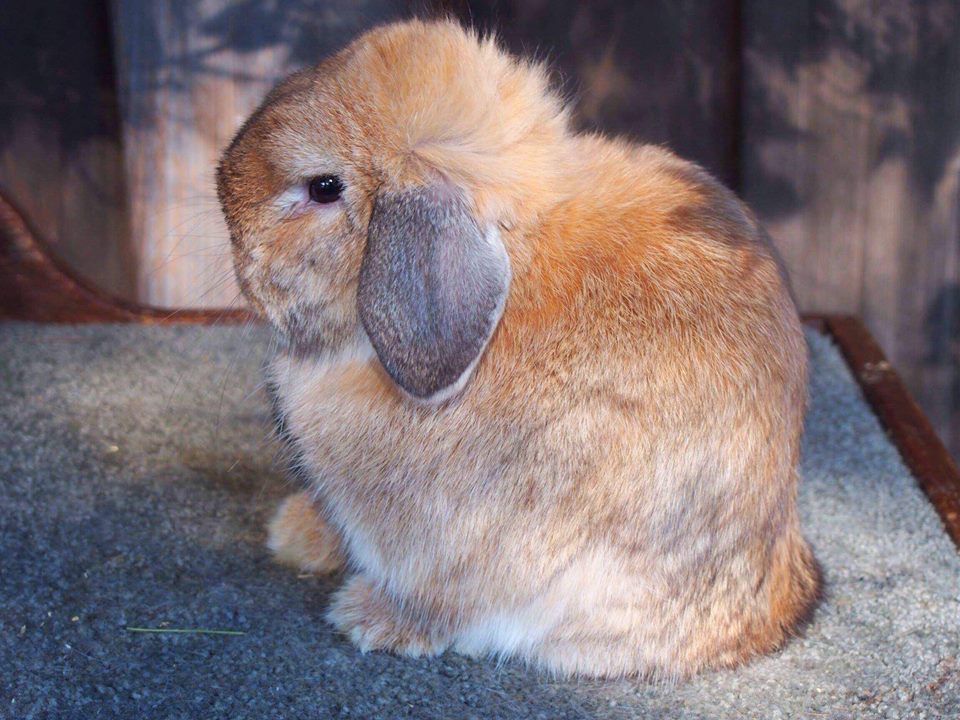Let's talk about ears! The ear is worth 10 points in the breed standard. The ear of a Holland Lop is one of the defining trademarks of the breed, and as such it's very important to understand how to evaluate it. A Holland with a correct ear is truly a thing of beauty!
Contained within this article are some example photos of correct ears that were borrowed with permission from my good friend, Chris Zemny. Thank you, Chris!
Contained within this article are some example photos of correct ears that were borrowed with permission from my good friend, Chris Zemny. Thank you, Chris!
First, let's talk about the openness of the ear. This, like many other aspects of the ear, is governed by the crown. Rabbits with more front-to-back width of crown will have a more open ear. In Holland Lops, we are looking for as wide an ear base as possible, as it dictates how wide the ear as a whole will likely be. The tort buck on the left has an extremely wide, open ear. Because he has very good front-to-back width of crown, the ear is also wide from front to back. The broken blue otter buck on the right has a very poor ear as a whole. Because he has very little front-to-back width of crown, the ear base is narrow and closed off. This results in a narrow ear shape from the base down.
The next thing to look for is roundness of the ear tips. A Holland Lop should have rounded, teaspoon shape at the bottom of the ears. Pointiness is very undesirable. The tort buck on the left has a pretty good shape to the tips of his ears. They are fairly well rounded and are not pointed. The tort doe on the right has poor ear shape. The tips are very pointed, which is undesirable.
As we already know, we want as wide of an ear as possible. A narrow ear base is undesirable, and goes hand-in-hand with another fault known as a 'folded' ear. When viewing the ear, we want it to be reasonably 'flat'. If there is a crease down the center, this is known as folding. It is incorrect and undesirable. The broken tort buck on the left displays a more correct ear that lacks any folding. The blue otter doe on the right is an extreme example of folding to the point where it's almost folded in half like a piece of paper. This is the result of a poor ear base and a lack of front-to-back width of crown.
A fault that is not often talked about in this breed is flattening on the posterior side of the ear. This is an exceedingly common fault, and it was next to impossible to find an example of a Holland Lop that did not have this issue. The broken tort doe on the left is not perfect, but was the closest to ideal that I could find. When nearing the ear tips on the posterior side of the ear, it should be rounded and not straight. While the broken tort doe on the left does still have a very minor flat spot, it is altogether a pretty respectable example of proper shape and roundness. The solid tort doe on the right has a very long flat spot on the back side of her ear, which also contributes to her pointed ear shape at the tips. Because ears carry a lot more points in English Lops, I'm sure there are much better examples of rounded ears in good examples of that breed than there are in Holland Lops.
We've talked about ear shape for a while now, so let's go ahead and dive into ear substance. Substance is essentially the thickness of the ear. It is best assessed by feeling the ear, but here are some examples that are pretty obvious just from photos. The tort buck on the left very clearly has wonderful ear substance. See how thick the ears look? That is ideal. The black silver marten on the right has poor ear substance. The ears lack thickness and are quite thin. This is incorrect.
The next aspect of the ear to understand is proper ear length. A lot of newer breeders tend to obsess over length when in reality, it is only one out of many aspects of the ear. Per the breed standard, the ideal ear length would be at or slightly below the jawline. The majority of true dwarf Holland Lops fall somewhere in that realm. The orange buck on the left has a very short ear that is slightly below the jawline. The broken tort doe on the right is an example of a true dwarf rabbit that still has too much length in the ear. Her ears dropped well over an inch below the jawline, which is undesirable.
The last thing we will talk about is furring. The ear should be well-furred, which, while it contributes to the appearance of thickness, is not synonymous with substance. We're going to re-use the photo of the broken tort doe as she honestly had one of the best sets of ears I've personally owned. You can't see any skin on the ear, just a solid layer of fur. The black silver marten buck on the right has poor ear furring. The skin is very clearly visible on a large portion of the ear, which is a telltale sign that there is not enough furring. From what I've seen, there are more Dwarfs out there with excellent ear furring than there are Hollands, so be sure to have a look at the top Dwarfs if you want to see good examples of ear furring!
That's it for now! I hope this article was helpful in bettering your understanding of Holland Lop ears. :)
That's it for now! I hope this article was helpful in bettering your understanding of Holland Lop ears. :)













